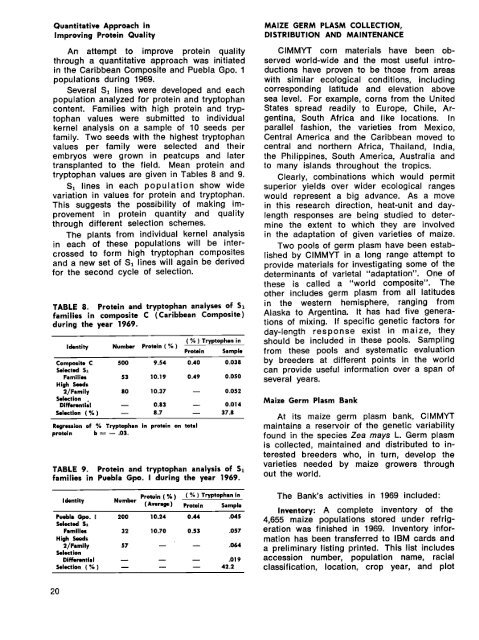REPORT - Search CIMMYT repository
REPORT - Search CIMMYT repository
REPORT - Search CIMMYT repository
Create successful ePaper yourself
Turn your PDF publications into a flip-book with our unique Google optimized e-Paper software.
Quantitative Approach in<br />
Improving Protein Quality<br />
An attempt to improve protein quality<br />
through a quantitative approach was initiated<br />
in the Caribbean Composite and Puebla Gpo. 1<br />
populations during 1969.<br />
Several S1 lines were developed and each<br />
population analyzed for protein and tryptophan<br />
content. Families with high protein and tryptophan<br />
values were submitted to individual<br />
kernel analysis on a sample of 10 seeds per<br />
family. Two seeds with the highest tryptophan<br />
values per family were selected and their<br />
embryos were grown in peatcups and later<br />
transplanted to the field. Mean protein and<br />
tryptophan values are given in Tables 8 and 9.<br />
S1 lines in each population show wide<br />
variation in values for protein and tryptophan.<br />
This suggests the possibility of making improvement<br />
in protein quantity and quality<br />
through different selection schemes.<br />
The plants from individual kernel analysis<br />
in each of these populations will be intercrossed<br />
to form high tryptophan composites<br />
and a new set of S1 lines will again be derived<br />
for the second cycle of selection.<br />
TABLE 8. Protein and tryptophan analyses of S1<br />
families in composite C (Caribbean Composite)<br />
during the year 1969.<br />
Identity<br />
Number Protein ( %)<br />
( % ) Tryptophan in<br />
Protein<br />
Sample<br />
Composite C 500 9.54 0.40 0.038<br />
Selected S,<br />
Families 53 10.19 0.49 0.050<br />
High Seeds<br />
2/Family 80 10.37 0.052<br />
Selection<br />
Differenti~1 0.83 0.014<br />
Selection (%) 8.7 37.8<br />
Regression of % Tryptophan in protein on total<br />
protoln b = - .03.<br />
TABLE 9. Protein and tryptophan analysis of S1<br />
families in Puebla Gpo. I during the year 1969.<br />
MAIZE GERM PLASM COLLECTION,<br />
DISTRIBUTION AND MAINTENANCE<br />
<strong>CIMMYT</strong> corn materials have been observed<br />
world-wide and the most useful introductions<br />
have proven to be those from areas<br />
with similar ecological conditions, inclUding<br />
corresponding latitude and elevation above<br />
sea level. For example, corns from the United<br />
States spread readily to Europe, Chile, Argentina,<br />
South Africa and like locations. In<br />
parallel fashion, the varieties from Mexico,<br />
Central America and the Caribbean moved to<br />
central and northern Africa, Thailand, India,<br />
the Philippines, South America, Australia and<br />
to many islands throughout the tropics.<br />
Clearly, combinations which would permit<br />
superior yields over wider ecological ranges<br />
would represent a big advance. As a move<br />
in this research direction, heat-unit and daylength<br />
responses are being studied to determine<br />
the extent to which they are involved<br />
in the adaptation of given varieties of maize.<br />
Two pools of germ plasm have been established<br />
by <strong>CIMMYT</strong> in a long range attempt to<br />
provide materials for investigating some of the<br />
determinants of varietal "adaptation". One of<br />
these is called a "world composite". The<br />
other includes germ plasm from all latitudes<br />
in the western hemisphere, ranging from<br />
Alaska to Argentina. It has had five generations<br />
of mixing. If specific genetic factors for<br />
day-length response exist in maize, they<br />
should be included in these pools. Sampling<br />
from these pools and systematic evaluation<br />
by breeders at different points in the world<br />
can provide useful information over a span of<br />
several years.<br />
Maize Germ Plasm Bank<br />
At its maize germ plasm bank, <strong>CIMMYT</strong><br />
maintains a reservoir of the genetic variability<br />
found in the species Zea mays L. Germ plasm<br />
is collected, maintained and distributed to interested<br />
breeders who, in turn, develop the<br />
varieties needed by maize growers through<br />
out the world.<br />
Iclontity<br />
Puebla Gpo. I<br />
Selected S.<br />
Families<br />
High Seeds<br />
2/Family<br />
Selection<br />
Differential<br />
Selection (%)<br />
N be Protoin ( % )<br />
um r (Avera.)<br />
200 10.24<br />
32 10.70<br />
57<br />
( % ) Tryptophan in<br />
Protein<br />
Samplo<br />
0.44 .045<br />
0.53 .057<br />
.064<br />
.019<br />
42.2<br />
The Bank's activities in 1969 included:<br />
Inventory: A complete inventory of the<br />
4,655 maize populations stored under refrigeration<br />
was finished in 1969. Inventory information<br />
has been transferred to IBM cards and<br />
a preliminary listing printed. This list includes<br />
accession number, population name, racial<br />
classification, location, crop year, and plot<br />
20

















